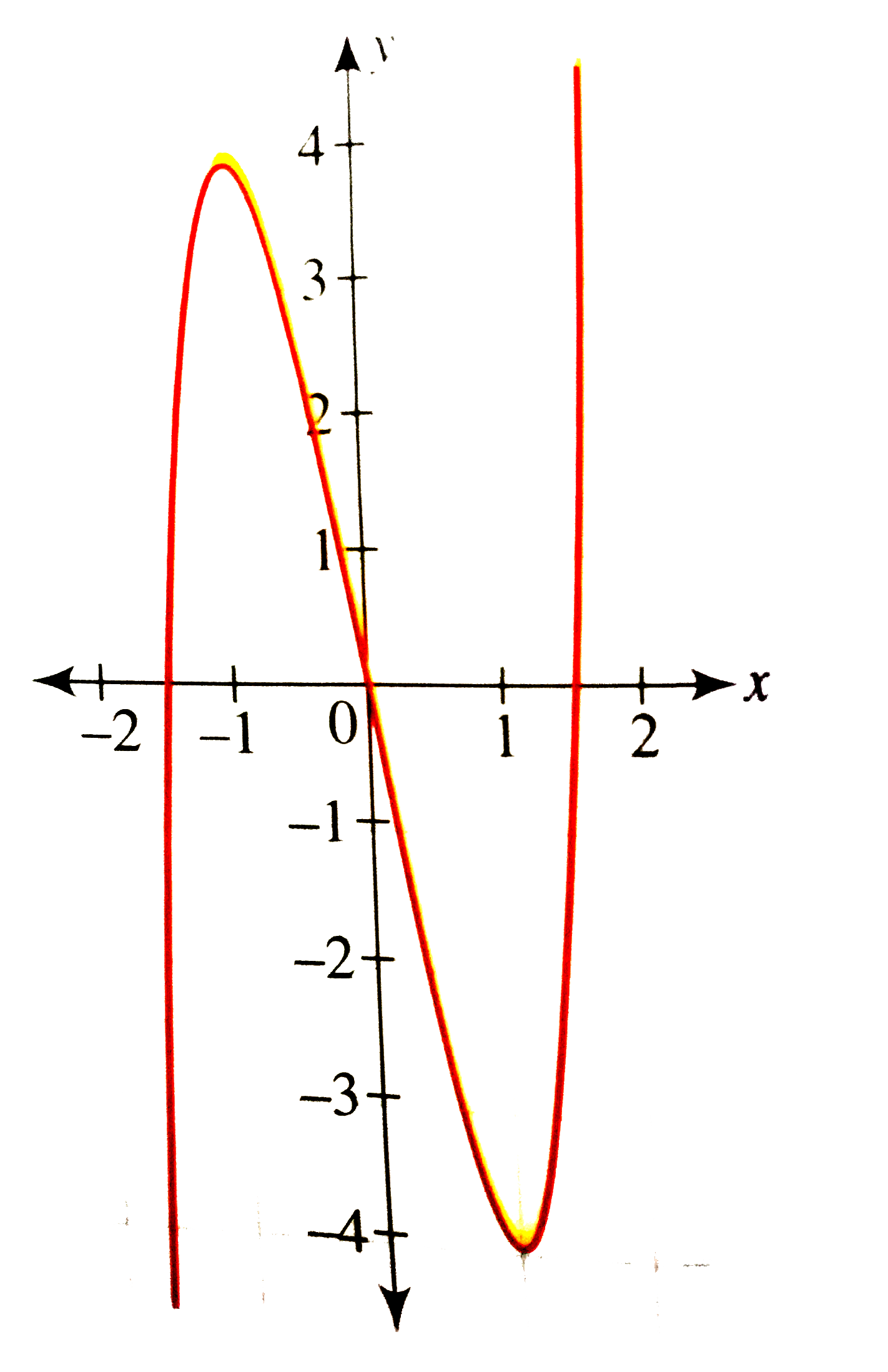Let a∈R and let f:R→ be given by f(x)=x5−5x+a, then (a) f(x) has three real roots if a>4 (b)f(x) has only one real roots if a>4 (c)f(x) has three real roots if a<−4 (d)f(x) has three real roots if −4<a<4Solution in Bengali
Let =f(x)=x5−5x
⇒f'(x)=5x4−5
=5(x4−1)
=5(x−1)(x+1)(x2+1)
f'(x)=0,∴x=−1,1
f''(x)=20x3
f''(1)=20 and f''(−1)=−20
So x = 1 is the point of minima and x = -1 is the point of maxima.
Also f(1)=−4 and f(−1)=4
Graph of y=f(x) is as shown in the adjacent figure.
From the graph, x5−5x=−a has one real root if −a<−4 or −a>4,
i.e. a>4 or a<−4
Also x5−5x=−a has three real roots if −4<−a<4
i.e. −4<a<4
Hence correct answers are (b) and (d).

Topper's Solved these Questions
- GRAPHS OF POLYNOMIAL AND RATIONAL FUNCTIONSBOOK - CENGAGE PUBLICATIONCHAPTER - GRAPHS OF POLYNOMIAL AND RATIONAL FUNCTIONSEXERCISE - Exercises
17 Videos
- GRAPHICAL TRANSFORMATIONSBOOK - CENGAGE PUBLICATIONCHAPTER - GRAPHICAL TRANSFORMATIONSEXERCISE - ILLUSTRATION
78 Videos
- GRAPHS OF ELEMENTARY FUNCTIONS BOOK - CENGAGE PUBLICATIONCHAPTER - GRAPHS OF ELEMENTARY FUNCTIONS EXERCISE - EXERCISES
34 Videos
Similar Questions
Draw the graph of y=(x−1)(x2−x+1).
View SolutionPlot y=|x|,y+x−2∣,andy=|x|2∣
View SolutionDraw the graph of y=1(1/x).
View SolutionLate a∈R and let f:R→ be given by f(x)=x5−5x+a, then f(x) has three real roots if a>4 f(x) has only one real roots if a>4 f(x) has three real roots if a<−4 f(x) has three real roots if −4<a<4
View SolutionLet f(x)=|x-1|+a|-4,quad if f(x)=0 has three real solution,then the values of lies in
View SolutionIf f(x)=x has non real roots, then the equation f(f(x))=x (A) has all real and unequal roots (B) has some real and non real roots (C) has all real and equal roots (D) has all non real roots
View SolutionLet f(x)=3x−2+4x−3+5x−4. Then f(x)=0 has (A) exactly one real root in (2,3) (B) exactly one real root in (3,4) (C) at least one real root in (2,3) (D) none of these
View SolutionLet a ∈ R and f : R→R be given by f(x)=x5−5x+a, then
(a) f(x)=0 has three real roots if a>4
(b) f(x)=0 has only one real root if a>4
(c) f(x)=0 has three real roots if a<−4
(d) f(x)=0 has three real roots if −4<a<4
View Solutionf(x) is a polynomial function, f:R→R, such that f(2x)=f'(x)f''(x). Equation f(x) = x has (A) three real and positive roots (B) three real and negative roots (C) one real root (D) three real roots such that sum of roots is zero
View SolutionLet a∈R and let f:R→ be given by f(x)=x5−5x+a, then (a) f(x) has three real roots if a>4 (b)f(x) has only one real roots if a>4 (c)f(x) has three real roots if a<−4 (d)f(x) has three real roots if −4<a<4
View SolutionLet a ∈ R and f : R→R be given by f(x)=x5−5x+a, then
(a) f(x)=0 has three real roots if a>4
(b) f(x)=0 has only one real root if a>4
(c) f(x)=0 has three real roots if a<−4
(d) f(x)=0 has three real roots if −4<a<4
View Solutionf(x) is a polynomial function, f:R→R, such that f(2x)=f'(x)f''(x). Equation f(x) = x has (A) three real and positive roots (B) three real and negative roots (C) one real root (D) three real roots such that sum of roots is zero
View SolutionIf f(x)=x has non real roots, then the equation f(f(x))=x (A) has all real and unequal roots (B) has some real and non real roots (C) has all real and equal roots (D) has all non real roots
View SolutionLet f(x)=3x−2+4x−3+5x−4. Then f(x)=0 has (A) exactly one real root in (2,3) (B) exactly one real root in (3,4) (C) at least one real root in (2,3) (D) none of these
View SolutionLate a in R and let f: Rvec be given by f(x)=x^5-5x+a , then f(x) has three real roots if a >4 f(x) has only one real roots if a >4 f(x) has three real roots if a<-4 f(x) has three real roots if -4
View SolutionLet a ∈ R and f : R→R be given by f(x)=x5−5x+a, then
(a) f(x)=0 has three real roots if a>4
(b) f(x)=0 has only one real root if a>4
(c) f(x)=0 has three real roots if a<−4
(d) f(x)=0 has three real roots if −4<a<4
View Solution
